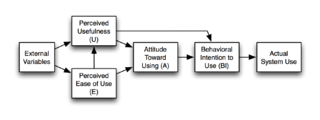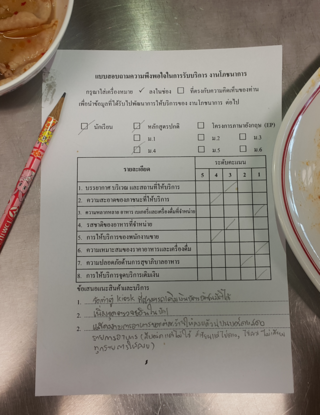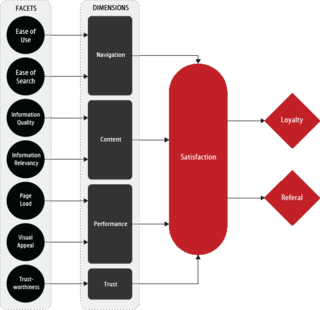Frederick Irving Herzberg was an American psychologist who became one of the most influential names in business management. He is most famous for introducing job enrichment and the Motivator-Hygiene theory. His 1968 publication "One More Time, How Do You Motivate Employees?" had sold 1.2 million reprints by 1987 and was the most requested article from the Harvard Business Review.

Usability can be described as the capacity of a system to provide a condition for its users to perform the tasks safely, effectively, and efficiently while enjoying the experience. In software engineering, usability is the degree to which a software can be used by specified consumers to achieve quantified objectives with effectiveness, efficiency, and satisfaction in a quantified context of use.

The technology acceptance model (TAM) is an information systems theory that models how users come to accept and use a technology.

Job satisfaction, employee satisfaction or work satisfaction is a measure of workers' contentment with their job, whether they like the job or individual aspects or facets of jobs, such as nature of work or supervision. Job satisfaction can be measured in cognitive (evaluative), affective, and behavioral components. Researchers have also noted that job satisfaction measures vary in the extent to which they measure feelings about the job. or cognitions about the job.

A personality test is a method of assessing human personality constructs. Most personality assessment instruments are in fact introspective self-report questionnaire measures or reports from life records (L-data) such as rating scales. Attempts to construct actual performance tests of personality have been very limited even though Raymond Cattell with his colleague Frank Warburton compiled a list of over 2000 separate objective tests that could be used in constructing objective personality tests. One exception however, was the Objective-Analytic Test Battery, a performance test designed to quantitatively measure 10 factor-analytically discerned personality trait dimensions. A major problem with both L-data and Q-data methods is that because of item transparency, rating scales and self-report questionnaires are highly susceptible to motivational and response distortion ranging all the way from lack of adequate self-insight to downright dissimulation depending on the reason/motivation for the assessment being undertaken.
The two-factor theory states that there are certain factors in the workplace that cause job satisfaction while a separate set of factors cause dissatisfaction, all of which act independently of each other. It was developed by psychologist Frederick Herzberg.

A questionnaire is a research instrument that consists of a set of questions for the purpose of gathering information from respondents through survey or statistical study. A research questionnaire is typically a mix of close-ended questions and open-ended questions. Open-ended, long-term questions offer the respondent the ability to elaborate on their thoughts. The Research questionnaire was developed by the Statistical Society of London in 1838.
The Kano model is a theory for product development and customer satisfaction developed in the 1980s by Noriaki Kano, which classifies customer preferences into five categories.
SERVQUAL is a multi-dimensional research instrument designed to capture consumer expectations and perceptions of a service along five dimensions that are believed to represent service quality. SERVQUAL is built on the expectancy–disconfirmation paradigm, which, in simple terms, means that service quality is understood as the extent to which consumers' pre-consumption expectations of quality are confirmed or disconfirmed by their actual perceptions of the service experience. When the SERVQUAL questionnaire was first published in 1985 by a team of academic researchers, A. Parasuraman, Valarie Zeithaml and Leonard L. Berry to measure quality in the service sector, it represented a breakthrough in the measurement methods used for service quality research. The diagnostic value of the instrument is supported by the model of service quality which forms the conceptual framework for the development of the scale. The instrument has been widely applied in a variety of contexts and cultural settings and found to be relatively robust. It has become the dominant measurement scale in the area of service quality. In spite of the long-standing interest in SERVQUAL and its myriad of context-specific applications, it has attracted some criticism from researchers.
The critical incident technique is a set of procedures used for collecting direct observations of human behavior that have critical significance and meet methodically defined criteria. These observations are then kept track of as incidents, which are then used to solve practical problems and develop broad psychological principles. A critical incident can be described as one that makes a contribution—either positively or negatively—to an activity or phenomenon. Critical incidents can be gathered in various ways, but typically respondents are asked to tell a story about an experience they have had.
Quality of experience (QoE) is a measure of the delight or annoyance of a customer's experiences with a service. QoE focuses on the entire service experience; it is a holistic concept, similar to the field of user experience, but with its roots in telecommunication. QoE is an emerging multidisciplinary field based on social psychology, cognitive science, economics, and engineering science, focused on understanding overall human quality requirements.
Cognitive style or thinking style is a concept used in cognitive psychology to describe the way individuals think, perceive and remember information. Cognitive style differs from cognitive ability, the latter being measured by aptitude tests or so-called intelligence tests. There is controversy over the exact meaning of the term "cognitive style" and whether it is a single or multiple dimension of human personality. However it remains a key concept in the areas of education and management. If a pupil has a cognitive style that is similar to that of his/her teacher, the chances are improved that the pupil will have a more positive learning experience. Likewise, team members with similar cognitive styles likely feel more positive about their participation with the team. While matching cognitive styles may make participants feel more comfortable when working with one another, this alone cannot guarantee the success of the outcome.
Managerial psychology is a sub-discipline of industrial and organizational psychology that focuses on the effectiveness of individuals and groups in the workplace, using behavioral science.
Quality of working life (QWL) describes a person's broader employment-related experience. Various authors and researchers have proposed models of quality of working life – also referred to as quality of worklife – which include a wide range of factors, sometimes classified as "motivator factors" which if present can make the job experience a positive one, and "hygiene factors" which if lacking are more associated with dissatisfaction. A number of rating scales have been developed aiming to measure overall quality of working life or certain aspects thereof. Some publications have drawn attention to the importance of QWL for both employees and employers, and also for national economic performance.
The Questionnaire For User Interaction Satisfaction (QUIS) is a tool developed to assess users' subjective satisfaction with specific aspects of the human-computer interface. It was developed in 1987 by a multi-disciplinary team of researchers at the University of Maryland Human–Computer Interaction Lab. The QUIS is currently at Version 7.0 with demographic questionnaire, a measure of overall system satisfaction along 6 scales, and measures of 9 specific interface factors. These 9 factors are: screen factors, terminology and system feedback, learning factors, system capabilities, technical manuals, on-line tutorials, multimedia, teleconferencing, and software installation. Currently available in: German, Italian, Portuguese, and Spanish.

The Webreep model is an information systems theory that explains and predicts website satisfaction, loyalty, and word-of-mouth. The model suggests that four factors directly influence website satisfaction. Website satisfaction, in turn, directly influences website visitor loyalty and likelihood of referral. Each factor is "shaped" by facets. The four dimensions and factors include:
Work motivation is a person's internal disposition toward work. To further this, an incentive is the anticipated reward or aversive event available in the environment. While motivation can often be used as a tool to help predict behavior, it varies greatly among individuals and must often be combined with ability and environmental factors to actually influence behavior and performance. Results from a 2012 study, which examined age-related differences in work motivation, suggest a "shift in people's motives" rather than a general decline in motivation with age. That is, it seemed that older employees were less motivated by extrinsically related features of a job, but more by intrinsically rewarding job features. Work motivation is strongly influenced by certain cultural characteristics. Between countries with comparable levels of economic development, collectivist countries tend to have higher levels of work motivation than do countries that tend toward individualism. Similarly measured, higher levels of work motivation can be found in countries that exhibit a long versus a short-term orientation. Also, while national income is not itself a strong predictor of work motivation, indicators that describe a nation's economic strength and stability, such as life expectancy, are. Work motivation decreases as a nation's long-term economic strength increases. Currently work motivation research has explored motivation that may not be consciously driven. This method goal setting is referred to as goal priming. Effects of primed subconscious goals in addition to goals that are consciously set related to job performance have been studied by Stajkovic, Latham, Sergent, and Peterson, who conducted research on a CEO of a for-profit business organization using goal priming to motivate job performance. Goal priming refers to the achievement of a goal by external cues given. These cues can affect information processing and behaviour the pursuit of this goal. In this study, the goal was primed by the CEO using achievement related words strategy placed in emails to employees. This seemingly small gesture alone not only cost the CEO very little money, but it increased objectively measured performance efficiency by 35% and effectiveness by 15% over the course of a 5-day work week. There has been controversy about the true efficacy of this work as to date, only four goal priming experiments have been conducted. However, the results of these studies found support for the hypothesis that primed goals do enhance performance in a for-profit business organization setting.
Employee motivation is an intrinsic and internal drive to put forth the necessary effort and action towards work-related activities. It has been broadly defined as the "psychological forces that determine the direction of a person's behavior in an organisation, a person's level of effort and a person's level of persistence". Also, "Motivation can be thought of as the willingness to expend energy to achieve a goal or a reward. Motivation at work has been defined as 'the sum of the processes that influence the arousal, direction, and maintenance of behaviors relevant to work settings'." Motivated employees are essential to the success of an organization as motivated employees are generally more productive at the work place.
Job characteristics theory is a theory of work design. It provides “a set of implementing principles for enriching jobs in organizational settings”. The original version of job characteristics theory proposed a model of five “core” job characteristics that affect five work-related outcomes through three psychological states.
Employee recognition is the timely, informal or formal acknowledgement of a person's behavior, effort, or business result that supports the organization's goals and values, and exceeds their superior's normal expectations. Recognition has been held to be a constructive response and a judgment made about a person's contribution, reflecting not just work performance but also personal dedication and engagement on a regular or ad hoc basis, and expressed formally or informally, individually or collectively, privately or publicly, and monetarily or non-monetarily.





